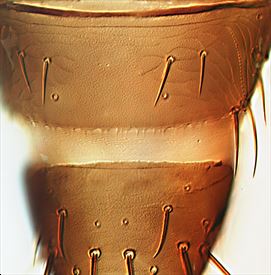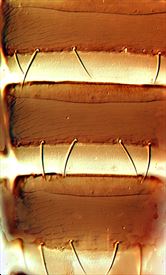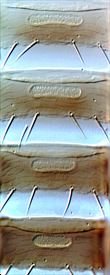Distinguishing features
Both sexes fully winged. Female brown, legs brown with tarsi and fore tibiae yellow; antennal segment III yellow IV-VII brown; fore wings brown with base scarcely paler. Antennae 7-segmented, III & IV constricted at apex with small forked sense cone; VII short. Head wider than long, with 2 pairs of ocellar setae; pair III small and arising just outside anterior margins of ocellar triangle; postocular setae pair I slightly longer than ocellar setae III. Pronotum with well-developed transverse lines of sculpture; 2 pairs of long posteroangular setae present; posterior margin with 3 pairs of setae. Metanotum with closely spaced, converging, longitudinal striae on posterior half, with faint dotted lines between the main striae; median setae arising behind anterior margin; campaniform sensilla present. Fore wing first and second veins with complete rows of setae; clavus with 5 marginal setae. Tergite II with 4 lateral marginal setae, the anterior seta small and arising on pleurotergite; tergites V–VIII with ctenidia present laterally, on VIII posteromesad to spiracles; posterior margin of VIII with complete but irregular comb of small microtrichia that sometimes arise in groups; pleurotergites without discal setae. Sternite II with 2 pairs of marginal setae, III–VII with 3 pairs, VII with median pair arising in front of margin; sternites without discal setae.
Male yellow with brown head; sternites III–VII each with a small, transverse pore plate; tergite VIII comb of irregular groups of very small microtrichia, tergite IX S1 setae longer than S2 and slightly closer to S2 than to each other.
Related species
There are 13 species of the genus Thrips recorded from New Zealand, out of a total of 280 species worldwide (Mound & Masumoto, 2005). Many of these species have the antennae clearly 7-segmented, whereas others have 8 segments. All members of Thrips genus have paired ctenidia on the tergites, and on tergite VIII these are postero-mesad to the spiracles, and they also lack ocellar setae pair I in front of the first ocellus. In contrast, Frankliniella species have ctenidia on tergite VIII antero-lateral to the spiracles, and a pair of setae is always present in front of the first ocellus. T. rhabdotus is unusual in having faint dotted lines between the main sculptured striae on the metanotum.
Biological data
Presumably feeding and breeding in flowers, this species is recorded from roses, Leucaena and Gardenia flowers.
Distribution data
Not recorded from New Zealand, but considered a high risk potential invader, this species was described from Tonga, and also recorded from Fiji (Palmer, 1992).
Family name
THRIPIDAE, THRIPINAE
Species name
Thrips rhabdotus Sakimura
Original name and synonyms
Thrips (Isothrips) rhabdotus Sakimura, 1969: 74.
References
Moritz G, Mound LA, Morris DC & Goldarazena A (2004) Pest thrips of the world – visual and molecular identification of pest thrips. CD-ROM published by CBIT Brisbane. http://www.cbit.uq.edu.au/software/pestthrips/default.htm
Palmer JM (1992) Thrips (Thysanoptera) from Pakistan to the Pacific: a review. Bulletin of the British Museum (Natural History) Entomology 61: 1–76.




